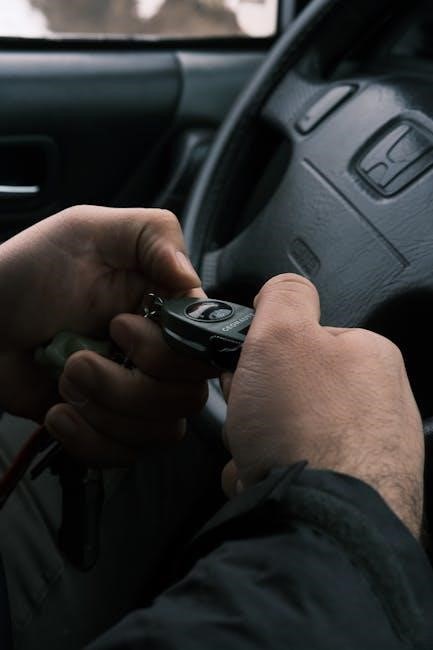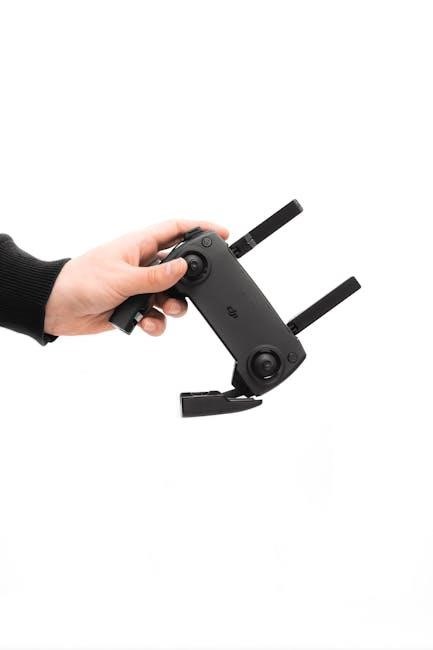The 2012 Honda Pilot manual provides essential information for owners, covering features, maintenance, and troubleshooting. It’s available for download as a PDF for easy reference.
1.1 Overview of the Honda Pilot 2012
The Honda Pilot 2012 is a mid-size SUV designed for versatility and reliability. Known for its spacious interior, comfortable seating for up to eight passengers, and ample cargo space, it’s ideal for families and adventurers alike. The 2012 model features a 3.5-liter V6 engine, delivering smooth performance and decent fuel efficiency. With its robust design and advanced safety features, the Pilot is a practical choice for daily driving and off-road excursions. Its reputation for durability and low maintenance costs makes it a popular option among SUV enthusiasts. This overview highlights its key attributes and why it remains a favored vehicle in its class.
1.2 Importance of the Owner’s Manual
The owner’s manual is a crucial resource for Honda Pilot 2012 owners, providing detailed guidance on operation, maintenance, and troubleshooting. It ensures safe and efficient use of the vehicle by explaining features, settings, and recommended practices. Regular reference to the manual helps owners optimize performance, adhere to maintenance schedules, and address potential issues promptly. Additionally, it serves as a comprehensive guide for understanding advanced technologies and safety systems integrated into the SUV. By following the manual, drivers can enhance their driving experience and extend the lifespan of their vehicle. It is essential for both new and experienced owners to familiarize themselves with its contents.
1.3 How to Download the 2012 Honda Pilot Manual
Downloading the 2012 Honda Pilot manual is straightforward. Visit official Honda websites or trusted forums like pilot-club.su for direct links. Select the desired language, such as English or Russian, and choose the PDF format. Ensure your device has enough storage, as files can be large. Once downloaded, save the manual for easy access. This digital version allows owners to quickly search and reference information, making it a convenient resource for maintenance, troubleshooting, and understanding vehicle features. Always verify the source to ensure authenticity and safety of the download.

Key Features of the Honda Pilot 2012
The 2012 Honda Pilot offers a spacious interior, seating up to eight, with advanced technology like a multi-angle rearview camera and Bluetooth connectivity, ensuring comfort and safety.
2.1 Design and Comfort Features
The 2012 Honda Pilot features a stylish and functional design, offering a roomy interior with seating for up to eight passengers. The cabin is equipped with premium cloth upholstery, ensuring comfort during long drives. The vehicle also includes ample cargo space, which can be expanded by folding the rear seats. Additional comfort features include tri-zone automatic climate control, allowing passengers to adjust temperature settings individually. The Pilot’s design emphasizes practicality and versatility, making it an ideal choice for families seeking a spacious and comfortable SUV.
2.2 Technology and Safety Features
The 2012 Honda Pilot incorporates advanced technology, including a multi-information display and Bluetooth connectivity for seamless audio and phone integration. The vehicle also features a rearview camera, enhancing visibility during reverse maneuvers. Safety is prioritized with a comprehensive airbag system, anti-lock braking (ABS), and electronic stability control. These features work together to provide a secure driving experience. The Pilot’s technology and safety elements are designed to enhance both convenience and protection, ensuring a confident and enjoyable journey for all occupants.
2.3 Performance and Fuel Efficiency
The 2012 Honda Pilot is powered by a 3.5-liter V6 engine, delivering smooth and responsive performance. It features a 5-speed automatic transmission and utilizes Variable Cylinder Management (VCM) to enhance fuel efficiency. The engine produces 250 horsepower and 253 lb-ft of torque, ensuring capable towing and hauling. With a fuel capacity of 21 gallons, the Pilot offers an EPA-estimated 17 MPG in the city, 23 MPG on the highway, and 20 MPG combined. This balance of power and efficiency makes it a versatile choice for both daily driving and adventurous trips.

Maintenance Schedule for Honda Pilot 2012
Regular maintenance ensures optimal performance. Schedule includes oil changes, tire rotations, and fluid checks. Follow the manual for detailed intervals to maintain longevity and efficiency.
3.1 Oil Change and Fluid Check
Regular oil changes are crucial for engine health. The 2012 Honda Pilot manual recommends synthetic oil for optimal performance. Check oil levels monthly and change every 5,000 to 7,500 miles. Additionally, inspect coolant, transmission, and brake fluids during maintenance. Proper fluid levels ensure smooth operation and prevent damage. Always refer to the manual for specific guidelines and recommendations. Regular checks help maintain performance and extend vehicle lifespan. Adhere to the schedule for a reliable and efficient driving experience.
3.2 Tire Rotation and Pressure Check
Regular tire rotation and pressure checks are essential for maintaining even tread wear and optimal performance. The 2012 Honda Pilot manual recommends rotating tires every 5,000 to 8,000 miles. Check tire pressure monthly and before long trips, using a gauge for accuracy. The recommended pressure is typically 35-40 PSI, depending on load. Proper tire maintenance enhances safety, fuel efficiency, and handling. Always adhere to the manual’s guidelines for specific instructions tailored to your vehicle. Consistent checks ensure reliable performance and extend tire lifespan.
3.3 Brake System Maintenance
Regular brake system maintenance is crucial for ensuring safety and reliability. Inspect brake pads every 10,000 to 15,000 miles and replace them when worn below 1/8 inch. Check rotors for excessive wear or warping and have them resurfaced or replaced as needed. Brake fluid levels should be checked monthly and topped up to the recommended level to prevent spongy brakes. Look for signs of leaks in brake lines and hoses. If any issues are detected, consult a certified mechanic promptly. Proper maintenance prevents braking system failure and ensures consistent stopping performance.

Technical Specifications of the Honda Pilot 2012
The 2012 Honda Pilot features a 3;5L V6 engine, 5-speed automatic transmission, and seats up to 8 passengers. It offers a fuel capacity of 21 gallons.
4.1 Engine and Transmission Details
The 2012 Honda Pilot is equipped with a 3.5-liter V6 engine, producing 250 horsepower at 5,700 RPM. It features a 5-speed automatic transmission with Variable Cylinder Management (VCM). This system enhances fuel efficiency by deactivating cylinders during low-demand driving conditions. The engine also includes a Multi-Point Fuel Injection system for optimal performance and reduced emissions. The transmission provides smooth shifting and is designed to handle both city and highway driving efficiently. Proper maintenance of the engine and transmission is crucial for longevity and performance, as outlined in the manual.
4.2 Dimensions and Weight
The 2012 Honda Pilot measures 191.4 inches in overall length, with a 109.2-inch wheelbase and 78.5 inches in width. Its height is 72.7 inches, providing ample interior space. The curb weight ranges from 4,345 to 4,655 pounds, depending on the trim level. The Gross Vehicle Weight Rating (GVWR) is 5,855 pounds, ensuring robust towing and hauling capabilities. These dimensions and weight distribution contribute to its stability and practicality as a mid-size SUV, making it suitable for both family use and adventurous trips.
4.3 Fuel Capacity and Economy
The 2012 Honda Pilot has a fuel tank capacity of 21 gallons, allowing for extended driving range. Front-wheel-drive models achieve an EPA-estimated 17 mpg in the city and 24 mpg on the highway. All-wheel-drive versions slightly lower, at 16 mpg city and 22 mpg highway. Actual mileage may vary based on driving conditions, habits, and maintenance. This balance of fuel efficiency and power makes the Pilot a practical choice for both urban commuting and long road trips, ensuring reliable performance without excessive fuel consumption.

Safety Features of the Honda Pilot 2012
The 2012 Honda Pilot features advanced safety technologies, including a comprehensive airbag system, electronic stability control, and anti-lock braking system (ABS) for enhanced driver and passenger protection.
5.1 Airbag System
The 2012 Honda Pilot is equipped with a sophisticated airbag system designed to maximize occupant safety. It includes dual-stage front airbags, front side airbags, and side curtain airbags with rollover sensors. These airbags deploy in the event of a collision to cushion impact and reduce injury risk. The system is integrated with seatbelt use, ensuring optimal protection. Rear seating positions also benefit from the side curtain airbags, providing comprehensive coverage for all passengers. This advanced airbag network is a key component of the Pilot’s commitment to safety and occupant protection.
5.2 Electronic Stability Control
The 2012 Honda Pilot features Electronic Stability Control (ESC), a vital safety system that enhances vehicle stability. By continuously monitoring driving conditions, ESC automatically adjusts engine power and applies selective braking to individual wheels to help maintain traction and control. This system is particularly effective in slippery or uneven road conditions, reducing the risk of skidding or loss of control. ESC works seamlessly with other safety features to provide a secure driving experience, ensuring the Pilot remains stable and responsive during various maneuvers.
5.3 Anti-Lock Braking System (ABS)
The 2012 Honda Pilot is equipped with an Anti-Lock Braking System (ABS), designed to improve safety during hard braking. ABS prevents wheel lock-up by rapidly pulsing brake pressure, ensuring tires maintain contact with the road. This system enhances control and stability, reducing stopping distances on various surfaces. ABS works in conjunction with other safety features like Electronic Stability Control to provide a secure driving experience. By preventing skidding and maintaining vehicle stability, ABS is a critical component of the Pilot’s safety suite, contributing to overall driver confidence and accident prevention capabilities.

Troubleshooting Common Issues

This section addresses common problems like warning lights, transmission issues, and cooling system malfunctions. It provides diagnostic steps and solutions for maintaining your Honda Pilot’s optimal performance.
6.1 Warning Lights and Their Meanings
The 2012 Honda Pilot manual details various dashboard warning lights, such as the engine light, brake light, and temperature light; Each light signals specific system issues. The engine light indicates potential engine or emissions problems, while the brake light warns of brake system malfunctions. The temperature light signals overheating. Consult the manual for precise meanings and troubleshooting steps to address these issues promptly. Understanding these indicators helps ensure safety and prevents costly repairs by identifying problems early. Always refer to the manual for accurate diagnostics and guidance.
6.2 Common Transmission Problems
The 2012 Honda Pilot manual highlights common transmission issues, such as slipping gears, hesitation, or delayed engagement. These problems often stem from worn clutch packs or faulty solenoids. In some cases, software updates or fluid replacements may resolve the issues. The manual provides troubleshooting steps and recommends regular transmission fluid checks to maintain smooth operation. Ignoring these signs can lead to costly repairs, so addressing them early is crucial. The manual also suggests consulting a professional if issues persist, ensuring the transmission remains reliable and efficient for years to come.
6.3 Cooling System Issues
The 2012 Honda Pilot manual addresses common cooling system problems, such as leaks, overheating, and radiator issues. It advises checking coolant levels, inspecting hoses for cracks, and ensuring the radiator cap is functional. The manual also recommends replacing the coolant every 100,000 miles to prevent corrosion. Additionally, it provides steps to bleed air from the system, which can cause inefficiency. If these issues persist, the manual suggests consulting a mechanic to avoid engine damage. Regular maintenance and timely repairs are emphasized to ensure optimal performance and longevity of the cooling system.

Infotainment and Navigation System
The 2012 Honda Pilot’s infotainment system offers Bluetooth, USB, and navigation setup. It’s designed for convenience, with voice commands and touchscreen controls for seamless connectivity and ease of use.
7.1 Overview of the Infotainment System
The 2012 Honda Pilot features an advanced infotainment system designed for connectivity and entertainment. With Bluetooth capability, the system supports hands-free calling and audio streaming. The USB interface allows seamless integration of external devices, such as iPods or USB drives, providing access to personal music libraries. Additionally, the navigation system offers voice-guided directions and real-time traffic updates, enhancing the driving experience. The system’s intuitive interface, complete with a high-resolution touchscreen, ensures easy access to various functions. Owners can also customize settings to suit their preferences, making the system both user-friendly and versatile for diverse needs.
7.2 Setting Up Navigation
Setting up the navigation system in your 2012 Honda Pilot is straightforward. Start by inserting the navigation DVD into the system. Ensure the vehicle is in park and the ignition is on. Select the navigation menu on the infotainment screen and follow the prompts to enter your PIN, if required. The system will then load the maps and be ready for use. Voice-guided directions and real-time traffic updates enhance accuracy. Regularly updating the navigation software ensures the latest maps and features. Refer to the manual for detailed instructions on customization and troubleshooting navigation functions to optimize your driving experience.
7.3 Bluetooth and Audio Connectivity
Pairing your device via Bluetooth in the 2012 Honda Pilot enables hands-free calls and audio streaming. Press the phone button, select “Connect Bluetooth Device,” and follow on-screen instructions. The system will guide you through pairing. Once connected, you can stream music or make calls wirelessly. For wired connections, use the USB or auxiliary ports. The infotainment system supports various audio formats, ensuring compatibility with most devices; Refer to the manual for troubleshooting common connectivity issues or updating the system’s firmware to maintain optimal performance and compatibility with newer devices for a seamless entertainment experience while driving;

Owner’s Manual Sections
The 2012 Honda Pilot manual includes sections like the table of contents, operating controls, and maintenance schedules. It also covers troubleshooting tips for common issues.
8.1 Table of Contents
The table of contents in the 2012 Honda Pilot manual organizes information for easy access. It lists sections such as introduction, features, maintenance, troubleshooting, and technical specifications. This structure ensures users can quickly find specific details about their vehicle, from understanding controls to scheduling maintenance. The table of contents serves as a roadmap, making the manual user-friendly and efficient for owners seeking guidance on any aspect of their Honda Pilot.
8.2 Operating Controls and Instruments
The 2012 Honda Pilot manual details the vehicle’s operating controls and instruments, ensuring drivers understand their functions. It covers the steering wheel controls, instrument panel, and infotainment system; The manual explains how to use features like cruise control, audio settings, and climate control. It also describes the dashboard indicators, including warning lights and gauges, to help drivers monitor their vehicle’s status. This section is designed to familiarize owners with the Pilot’s systems, enabling safe and efficient operation. By understanding these controls, drivers can optimize their driving experience and maintain their vehicle’s performance effectively.
8.3 Maintenance and Service
The 2012 Honda Pilot manual emphasizes the importance of regular maintenance to ensure optimal performance and longevity. It outlines recommended service intervals, such as oil changes every 5,000 to 7,500 miles and tire rotations every 6,000 to 8,000 miles. The manual also provides guidelines for inspecting brakes, belts, and fluid levels. Proper maintenance helps prevent issues, reduces repair costs, and ensures the vehicle operates safely and efficiently. By following the manual’s maintenance schedule, owners can extend the life of their Honda Pilot and maintain its reliability over time.

Repair and Service Manual
The 2012 Honda Pilot Repair Manual offers detailed instructions for DIY fixes and professional servicing, including electrical diagrams and troubleshooting guides for optimal vehicle maintenance.
9.1 Overview of the Repair Manual
The 2012 Honda Pilot Repair Manual is a comprehensive guide designed for both DIY enthusiasts and professional mechanics. It covers a wide range of topics, including electrical systems, engine repair, and chassis maintenance. The manual is divided into sections for easy navigation, with detailed diagrams and step-by-step instructions to help users diagnose and fix issues efficiently. Whether you’re performing routine maintenance or complex repairs, this manual provides the necessary information to ensure your Honda Pilot runs smoothly. It’s available for download in PDF format, making it accessible anytime, anywhere.
9.2 DIY Repair Tips
The 2012 Honda Pilot Repair Manual offers valuable DIY repair tips, empowering owners to handle minor fixes independently. It provides step-by-step guidance for common repairs, such as brake pad replacements and cooling system checks. The manual emphasizes the importance of using genuine Honda parts for reliability. Before starting any repair, consult the manual for specific instructions and safety precautions. Regular maintenance tasks, like oil changes and tire rotations, are also detailed to keep your vehicle in optimal condition; While DIY repairs can save time and money, complex issues may require professional assistance to ensure safety and effectiveness.
9.3 Where to Find Repair Guides
Repair guides for the 2012 Honda Pilot are available through various online sources, including the official Honda website and forums like pilot-club.su. These resources offer detailed manuals, such as the 2012 Honda Pilot Service Manual, which covers electrical systems and mechanical repairs. Additionally, websites provide downloadable PDF versions of the owner’s manual and repair guides in both English and Russian. For example, the 2012 Honda Pilot Owners Manual is available in English (681 pages, 15 MB) and Russian (466 pages, 17 MB). These guides are essential for DIY enthusiasts and professionals alike, ensuring accurate and safe repairs.
The 2012 Honda Pilot manual is a comprehensive guide essential for owners and technicians, providing detailed information on features, maintenance, and repairs, ensuring optimal vehicle performance and longevity for users worldwide.
10;1 Summary of Key Points
The 2012 Honda Pilot manual offers detailed insights into the vehicle’s features, maintenance, and troubleshooting. It covers design, technology, performance, and safety aspects, ensuring owners understand their vehicle. Regular maintenance schedules, technical specifications, and repair guidance are included. The manual emphasizes optimal performance and longevity. Available in English and Russian, it provides accessible information for global users. Digital formats allow easy reference, making it an indispensable resource for both owners and technicians. By following the manual, drivers can ensure their Honda Pilot operates safely and efficiently, adhering to recommended practices for years of reliable service.
10.2 Importance of Regular Maintenance
Regular maintenance is crucial for extending the life of your 2012 Honda Pilot. It ensures optimal performance, safety, and fuel efficiency. By following the recommended schedules, you can prevent costly repairs and maintain reliability. Oil changes, tire rotations, and fluid checks are essential. The manual provides detailed guidelines for these tasks, ensuring your vehicle runs smoothly. Neglecting maintenance can lead to premature wear and potential breakdowns. Staying proactive protects your investment and enhances driving safety. Always refer to the manual for specific recommendations tailored to your Honda Pilot.
10.3 Additional Resources for Honda Pilot Owners
Beyond the manual, Honda Pilot owners can access various resources for enhanced support. Official Honda websites and forums offer detailed guides, repair tips, and troubleshooting advice. Additionally, websites like pilot-club.su provide comprehensive repair manuals and community discussions. For technical specifications, brochures, and navigation guides, platforms like honda.com are invaluable. Owners can also download PDF versions of the manual in multiple languages, ensuring accessibility. These resources empower owners to maintain and customize their vehicles effectively, fostering a stronger connection with their Honda Pilot.